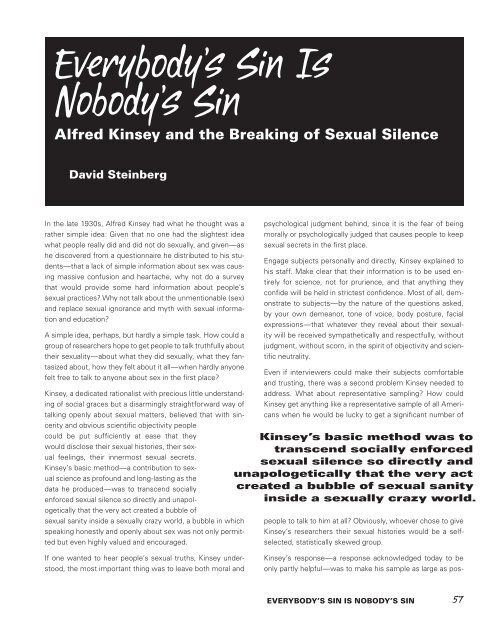You also want an ePaper? Increase the reach of your titles
YUMPU automatically turns print PDFs into web optimized ePapers that Google loves.
Everybody’s Sin Is<br />
Nobody’s Sin<br />
Alfred Kinsey and the Breaking of Sexual Silence<br />
David Steinberg<br />
In the late 1930s, Alfred Kinsey had what he thought was a<br />
rather simple idea: Given that no one had the slightest idea<br />
what people really did and did not do sexually, and given—as<br />
he discovered from a questionnaire he distributed to his students—that<br />
a lack of simple information about sex was causing<br />
massive confusion and heartache, why not do a survey<br />
that would provide some hard information about people’s<br />
sexual practices? Why not talk about the unmentionable (sex)<br />
and replace sexual ignorance and myth with sexual information<br />
and education?<br />
A simple idea, perhaps, but hardly a simple task. How could a<br />
group of researchers hope to get people to talk truthfully about<br />
their sexuality—about what they did sexually, what they fantasized<br />
about, how they felt about it all—when hardly anyone<br />
felt free to talk to anyone about sex in the first place?<br />
Kinsey, a dedicated rationalist with precious little understanding<br />
of social graces but a disarmingly straightforward way of<br />
talking openly about sexual matters, believed that with sincerity<br />
and obvious scientific objectivity people<br />
could be put sufficiently at ease that they<br />
would disclose their sexual histories, their sexual<br />
feelings, their innermost sexual secrets.<br />
Kinsey’s basic method—a contribution to sexual<br />
science as profound and long-lasting as the<br />
data he produced—was to transcend socially<br />
enforced sexual silence so directly and unapologetically<br />
that the very act created a bubble of<br />
sexual sanity inside a sexually crazy world, a bubble in which<br />
speaking honestly and openly about sex was not only permitted<br />
but even highly valued and encouraged.<br />
psychological judgment behind, since it is the fear of being<br />
morally or psychologically judged that causes people to keep<br />
sexual secrets in the first place.<br />
Engage subjects personally and directly, Kinsey explained to<br />
his staff. Make clear that their information is to be used entirely<br />
for science, not for prurience, and that anything they<br />
confide will be held in strictest confidence. Most of all, demonstrate<br />
to subjects—by the nature of the questions asked,<br />
by your own demeanor, tone of voice, body posture, facial<br />
expressions—that whatever they reveal about their sexuality<br />
will be received sympathetically and respectfully, without<br />
judgment, without scorn, in the spirit of objectivity and scientific<br />
neutrality.<br />
Even if interviewers could make their subjects comfortable<br />
and trusting, there was a second problem Kinsey needed to<br />
address. What about representative sampling? How could<br />
Kinsey get anything like a representative sample of all Americans<br />
when he would be lucky to get a significant number of<br />
Kinsey’s basic method was to<br />
transcend socially enforced<br />
sexual silence so directly and<br />
unapologetically that the very act<br />
created a bubble of sexual sanity<br />
inside a sexually crazy world.<br />
people to talk to him at all? Obviously, whoever chose to give<br />
Kinsey’s researchers their sexual histories would be a selfselected,<br />
statistically skewed group.<br />
If one wanted to hear people’s sexual truths, Kinsey understood,<br />
the most important thing was to leave both moral and<br />
Kinsey’s response—a response acknowledged today to be<br />
only partly helpful—was to make his sample as large as pos-<br />
EVERYBODY’S SIN IS NOBODY’S SIN 57


